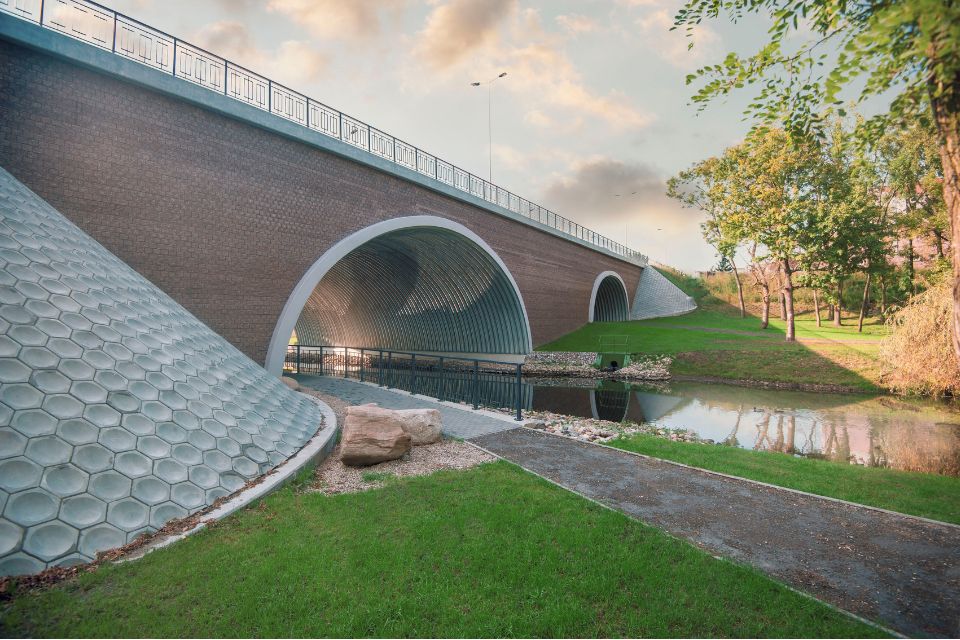The outlook for infrastructure construction in 2025
Take a look at global news, and headlines scream that climate change is here. What does that mean for the outlook for infrastructure construction in 2025 and in the future? One of the best – and one of few – things we can do working in the infrastructure sector is think about and plan for building sustainably, for the long term. Infrastructure construction and its use contributes to climate change – meaning that we need to rethink and reimagine what infrastructure and building it can and should look like.
What kinds of investments can be made now that can help ensure that infrastructure does not contribute to, and can actively mitigate, the harm brought about by climate change? At the eye of the climate-change storm, we are experiencing extreme events – unprecedented flooding and drought, unthinkable heatwaves, wildfires all year round, made worse by accelerating effects of a changing climate, such as severe storms and winds that make typical weather events into disasters.
At the same time, is it possible for society and its development to stand still? Apart from an unusually inactive period during the Covid-19 pandemic, society continues to move forward and requires supporting infrastructure – from reliable public transport and networks, roads, bridges and so on to carry it, to more advanced approaches to water management and strengthening the ground we build on.
In 2025, we believe sustainability is perhaps the most critical issue facing the world and our industry, but other factors also play key roles in civil and environmental engineering and the global infrastructure trends guiding our work.
Global infrastructure trends in 2025
Sustainability
“Sustainability” can be a blanket term that masks real outcomes and creates a risk of greenwashing. However, with the proliferation of regulatory requirements coupled with standards bodies, such as the Science Based Targets initiative (SBTi), it is more important – and easier than ever – to hold ourselves to account to gauge whether our aims toward net zero are moving forward and at what rate. We can see more clearly where we need to improve and what the barriers might be to achieving these targets. And we can gain a better understanding of how to match sustainability from our own perspective with the sustainability and environmental goals of our customers.
A part of understanding the future of sustainability demands clarity on population movements and mass urbanization. Consultancy PwC reported that population growth in cities would grow from 3.9 billion people to 6.3 billion by 2050, which puts a new and unique strain on urban infrastructure in particular. While a growing urban population might make better use of space and public transport, for example, water management issues in the face of increased flooding means that creative solutions will be required for keeping urban life moving, mitigating the effects of storms and floods – and preparing for potential drought conditions as well (for evidence of the disastrous effects of prolonged drought combined with wildfire conditions look no further than the January 2025 wildfires in Los Angeles, California).
Several other market trends indicate that while circularity and sustainability are critical, achieving these aims is not entirely straightforward.
Geopolitical uncertainty
It is difficult to predict whether 2025 will bring improvements to the global economic situation and geopolitical uncertainty. Since the war in Ukraine began several years ago, more conflicts have arisen throughout the world. Similarly, political issues – both those connected to these conflicts and otherwise – add an element of unpredictability. For infrastructure, this can mean that some regions are too unstable to build in or that funding is disrupted. At the same time, conflict or disaster areas working on recovery may be at a crossroads in their development, deciding to build more sustainably as they rebuild their infrastructure.
It remains to be seen how this plays out, but we have started to see signs in late 2024 of market normalization.
Materials transition
While different building materials each have their place, achieving circularity and longer lifespans for infrastructure projects demands that we look at low-emissions materials to help accelerate the journey to net zero. But, as consultancy firm McKinsey states, the “production, use, and eventual disposal of industrial materials such as steel, plastics, aluminum, and cement also account for almost a quarter of all global CO2 emissions”, which means countries, businesses, organizations, and leaders in the infrastructure industry should move toward lower-impact production and application of all of these materials, calculating the lifecycle costs and impacts for the materials selected to secure the most sustainable use, reuse or recycling potential for these materials.
While ideally construction would always take sustainability of materials into account, cost frequently drives these decisions. In the absence of strict regulation on circularity and sustainability, leaders in the infrastructure industry are in a position to influence the materials transition. We discuss reduced carbon footprint steel, for example, and belong to the SteelZero initiative to help drive net-zero steel and promote steel as a long-lasting building material that can cost less than alternatives over its lifespan while also being 100% recyclable. For companies and organizations looking at the long term, including future regulations, it makes sense to consider the materials transition as a priority.
Smart technology
The future of most industries – including infrastructure – will be underpinned by advances in technology, some of which is “smart” in the sense that it can provide insights beyond the scope of what traditional technology is capable of. From automating processes to creating efficiencies in project construction and delivery, from using data-driven predictive technology and AI for advanced modeling and projection to implementing smart monitors that can do everything from improving safety to providing insights on infrastructure performance, smart technology is virtually limitless in terms of the benefits it can provide on a mass scale.
The barriers to adoption, however, are real. The construction industry has been slow to embrace digital technology, but 2025 might be the turning point as a convergence of factors make tech adoption essential. As PwC notes, emerging technologies will be integral to solving infrastructure challenges, “facilitating the transition to low-carbon, climate-resilient assets and unlocking more sustainable business models”. At the same time, technology is disruptive in both good and challenging ways. Yet, technology adoption and smart solutions will be core to innovation and sustainability gains in 2025 and beyond.

